Release Date: January 3rd, 1942
Series: Merrie Melodies
Director: Friz Freleng
Story: Mike Maltese
Animation: Cal Dalton
Musical Direction: Carl Stalling
Starring: Mel Blanc (Hopalong Casserole, Stan Laurel, Oliver Hardy)
(You may view the cartoon here, albeit unrestored, or on HBO Max!)
Continuing the trend of artistic evolution and growth, 1942 proves yet again to be a significant year for the fate of Warner cartoons. Perhaps 1941 was more formative in planting the foundation that was initially conceived through the metaphorical blueprints and assimilation of materials in 1940: Bob Clampett’s adoption of Tex Avery’s unit, Bugs Bunny acclimating to his role as a skyrocketing star, and two Oscar nominations.
1942 may not yield any Oscar nominations for the Warner crew, but that certainly isn’t indicative of a lapse in quality. The Warner identity continues to solidify; this year marks the first ever color cartoon released under the Looney Tunes series, the first of its kind to do so in the 12 years the studio has been releasing cartoons, Frank Tashlin returns to assume the director’s chair as Norm McCabe leaves for the draft (though it wouldn’t be until the 1943 release season that this becomes apparent), Chuck Jones officially hits his comedic stride through such efforts as The Draft Horse and The Dover Boys at Pimento University, US involvement in the war is now reflected through the beginnings of propaganda cartoons, and confidence in direction from all across the board solidifies.Hop, Skip and a Chump is an apt cartoon to introduce the year. Seemingly inconsequential, menial, another drop in the bucket of Friz Freleng’s expansive filmography, it instead boasts some particularly tight and even experimental directing. There’s a clear desire to innovate and evolve; always a promising note to open on.
Stan Laurel and Oliver Hardy are most remembered for their heyday in the ‘30s, which is why it is relatively surprising it took Freleng (or any of the directors) this long to center an entire cartoon on their likeness. Said likeness has dominated a multitude of Warner cartoons throughout the ‘30s, even as early as the Bosko era with Bosko’s Picture Show, but never have they been utilized in the long form. Until now.
The short chronicles the continued trickery from a cornpone grasshopper—logically named Hopalong Casserole, of course—as he escapes the clutches of Laurel and Hardy, now immortalized as a pair of blackbirds with an appetite for grasshopper.Rather than directly opening to the grasshopper going about his daily rounds, or perhaps a direct introduction to the Laurel and Hardy birds expressing their desire for said grasshopper, Freleng instead adopts the way of interactivity: a black fade lifts up to reveal the camera jolting in cyclical hops. No musical score of any kind. Only the echo of the repetitive “boing!” on a mouth harp—already connecting to the cornpone theming soon to be revealed—and rotating glimpses of a wheat field.
Proficiency through tightness in brush control and vibrant colors certainly aid the impact of such an opening. Given that the background painting is the audience’s first impression of the cartoon—and a rather intimate one at that—the intended effect would be lost if a lesser painter were to handle it. There’s power in notable, streaky brush strokes and abstraction, but the solidity here benefits Freleng’s intentions best.
Curiosity decidedly piqued from the audience, matters now turn to unearthing who this purveyor of monotonous jumping is. The actual act of the grasshopper springing out from the field is seamless; the camera maintains its cycle, (disguising any potential technical follies through such extraneous movement, though that isn’t an issue here) the indications in the cel where the grasshopper interacts with the environments hook-up faithfully, and the motion itself feels uninterrupted. As though we’ve caught him—or, more truthfully, he’s caught us—in the middle of his grasshopper affairs. No grandiose preparations or wind-up or anything of the sort. Very seamless and clean.
Especially the transition to humor. Banking on the viewers to be lulled into a sense of monotony, the hopping of the grasshopper quickly turns musical to a degree of amusing obtuseness through how short and rapid the hops are. This change of pace exists solely to accompany the perky musical motif in the background. It’s a sharp demonstration of self awareness; self awareness from both Freleng and the grasshopper. Fleetingly dramatic smears and arcs ensure the movement avoids any unintentional choppiness. A boost of energy inherent to their usage is much appreciated, too.
Streamlining in camera operation and animation alike extend to the grasshopper coming to a stop. One that is decidedly more anthropomorphic than his four legged jumping… sans sweater, shoes, and straw boater hat. Whereas the grasshopper seamlessly assumes his position, curated through the brevity of one’s and sweeping arcs, the camera lags behind for an extra millisecond. Not out of technical negligence; rather, to demonstrate how spry our presumed hero of the story is, to the effect where he’s even too fast for his filmmakers. Utilization of the cornstalk as a frame around the character is an additionally solid consideration.
“Hopalong Casserole’s m’name!” Blanc speaks in a rather standard but nevertheless animated southern drawl, appropriately mush mouthed and thick in his words. Dick Bickenbach offers his services for this little one-on-one between insect and audience, immediately evident through the eye blink lines, extraneous wrinkles when he puffs out his shirt, indicated reflective whites in his eyes, and the presiding solidity in construction conducted under fresh, snappy movements. A fine casting choice on Freleng’s behalf. Long dialogue scenes can grow monotonous, but not when under the care of a proficiently engaging animator.
A sudden beat as he seems taken off-guard, Carl Stalling’s score of “Corn Pickin’” taking the momentary spotlight. Perhaps this moment was a bit too candid—the grasshopper loses his cheery smile in favor of pardoning himself…
…and spitting off-screen. Obtuseness of the cornstalk’s presence wasn’t only for the sake of guiding the audience’s eye, but encouraging a broiling gag in which the grasshopper has to dodge censors. He’s certainly not the first comedic trifecta of “grasshopper-spitting-censorship” to grace this cartoon.
All of which are made perfectly clear through his next aside: “Expect-er-atin’ a censored, y’know.” Worth noting is Bob Clampett’s twist on a very similar gag in the preceding year which, ironically, has been cut out of most copies of the cartoon.
On the topic of expecteratin’, a take from the grasshopper directed towards something off screen indicates someone’s been expecteratin’ him, too. This prompts him to ask the camera to move in closer…
…which is done obligingly. Freleng maintains this surprisingly interactive and immersive camerawork first indicated by tracking the grasshopper’s movements—for a director who didn’t often preoccupy himself with such comparatively “fluffy” directing, the desire to experiment is certainly felt.
Hopalong Casserole inquires the camera to move in closer yet again. The audience and filmmakers alike are mere spectators. Amicable as he is, the grasshopper boats a rather commanding presence which, again, amounts to a novel approach in directing. Very rarely have characters addressed the camera in such an abstract way, asking to do their bidding.
“Don’t look now, but over t’ m’ right are a couple a’ birds watchin’ me.”
Indeed; evidenced through an obliging camera pan, two eyes furtively peer from the depths of a shrouded shrub. Casserole presents a sense of all-knowing confidence—to us, those birds are nameless, faceless disembodied eyes that seem completely tangential to the narrative. There is no physical indication of any kind that these are birds—predatory ones, for that matter. Yet again, the chase dynamic soon orchestrated by this cartoon is rendered more intriguing and less monotonous through such immersive storytelling. Pegging these predators as longtime rivals bestows a certain richness to the short that is especially imperative to preserve in the inherent simplicity of chase cartoons.
Such is furthered through more self-assured orating from Casserole: “I just think I’ll have a little fun with ‘em,” is, again, a much less trite of initiating a chase than any standard fare of starving birds and an unassuming grasshopper. This is all a matter of having fun—entertaining the audience and himself, rather than being locked in a genuine scramble.
The eyeball gag in Sport Chumpions receives a second wind and fresh coat of varnish through a close-up of the birds watching Casserole hop away. Perhaps there’s an uncanniness to the perfectly spherical eye shapes. Yet, then again, these perfect spheres house a stronger symmetry that overall benefits the coherence of the gag. Cyclically hopping pupils are the takeaway over what houses them.
That, and it preserves the surprise aspect that is ensured through the forthcoming reveal. Up until this point, the birds have been preserved in total anonymity (excusing the fact that the audience knows that they are birds and predatory birds.) Unique eye shapes may allude too sharply to their owners; instead, the reveal of the Stan and Ollie caricatures is intended to be a funny, unexpected reveal. The designs are the dead giveaway, as is Stalling’s off-kilter interpretation of their theme song. Audiences would have laughed at the first sight of the cartoon’s antagonists—Freleng’s exercising of caution and ensuring there’s a surprise aspect to be had through obscuring their features is not taken for granted.
Bickenbach’s animation style remains present and recognizable through eye blink lines, a plethora of drybrushing in more violent gestures (such as the Hardy bird doing a take and shoving his Laurel counterpart into frame), and continually deft timing. A similarly worthy accompaniment to a relatively lengthy dialogue scene, as was the case with Casserole’s formal introduction.
Mel Blanc will always sound like Mel Blanc, but, in true Blanc-ian form, he remains relatively faithful to the inflections of Laurel and especially Hardy. Particularly the “mmmph!” from Hardy as he mimics clubbing the grasshopper over the head; it really does amaze to think that none of the Laurel and Hardy caricatures in these shorts thus far have been accompanied with vocal impersonations. One exception is the many instances in which a character mimics the intelligible whine-crying of Stan Laurel, but that in itself isn’t necessarily a conscious impression of his voice so much as it is an approximation or an homage.
A greater sense of anticipation is built through the camera panning left in accordance to the Laurel bird hiding behind the tree. With “Hardy” in the bushes and “Laurel” in position, audiences are expected to brace themselves for the inevitable crossing of a grasshopper. There’s too much availability and expansiveness in the layout to entertain any other alternative…
…which is what makes it so brilliant, given that Freleng deliberately subverts expectations with the availability of the layout and instead cuts to Casserole sneaking behind the Laurel bird. Between the constant sense of movement and glaciality in motion, Gil Turner’s animation is exceedingly apparent. Just as it’s exceedingly apparent he’s no Dick Bickenbach.
Many of these dissections of Bob Clampett’s cartoons mention the curse of John Carey, in that his draftsmanship sets such a high standard for quality that anyone else stacked against him is doomed to presumed inadequacy, even if their animation is, in fact, just fine. Here, in Freleng’s unit, Dick Bickenbach assumes that very role. It is truthful that Turner’s animation has its weaknesses, but his congruence of Casserole and a delightfully oblivious Laurel conversing is serviceable. Regardless, juxtaposed against the inarguable solidity of Bickenbach’s work, the comparative lapse in quality is noticeable.
Perhaps predictably, the Laurel bird never catches on to the fact that he’s making small talk with the very subject of conversation (“We’re going to catch… a grasshoppah!”). With a sense of triumph, the camera dutifully pans to the shrubbery, ditzy flute motif adding a sardonic commentary where Casserole and Laurel do not.
There isn’t much to be said. Blanc’s “Oomph!” from the Hardy bird again remains faithful to the vocal stylings of the real Oliver Hardy—actual animation of the impact isn’t as grandiose as it has the potential to be, but it doesn’t necessarily need to be a wild take. Stolidity in such a simple clubbing matches both Freleng’s no-nonsense directing style and the grounded physics of the real life Laurel and Hardy. Oliver Hardy doesn’t engage in wild, eye bulging or limb flailing takes.
Contemptuous finger tapping can and has become a bit of a cartoon cliché in a way, but remains another very true to life observation of Hardy’s mannerisms.
Gil Turner’s animation of the grasshopper galloping suffers from the usual glaciality, reading as though he’s floating rather than actually propelling himself forward, but is nevertheless harmless in that focus is delegated to the birds instead. Context and tone of the scene doesn’t dictate the need for a grandiose jump.
Likewise, any accidental lugubriousness is soon rectified through the furious scramble of the Hardy bird grabbing the club. Framing of the scene is subtle, but the Hardy bird taking up the negative space between the two tree roots and the Laurel bird standing parallel to the edge of the tree is a smart utilization of the composition and keeps the actions clear.
“That was a grasshopper,” proves again to be an astute observation of Hardy’s vocal mannerisms and reactions to any accidental abuse from Laurel.
As if to enunciate his point, the camera cuts directly to the grasshopper in question hopping along and hiding in the bushes. Both a way to rub salt in the wound at how it got away, as well as subliminally insult the Laurel bird’s intelligence by spelling everything out for him.
Next means of nabbing the grasshopper: capturing him in a sack. Blanc and writer Mike Maltese yet again manage to encapsulate Hardy’s tense condescension perfectly. His addition of “And this time, don’t let him get away!” seems to—again—rub the aforementioned loss in his face. Thankfully, as is true to Laurel’s shtick, the Laurel bird takes it in stride with enviable oblivion.
Dissolving to a close-up of the grasshopper lounging on a leaf parallels an exceptionally similar layout in Freleng’s The Wacky Worm. This time, however, the composition subliminally allows more space for the Laurel bird to make his entrance; the grasses in the foreground and density of leaves in the background do a good job of filling in the space, but the negative space unoccupied by the grasshopper proves just ripe to house an oblivious worm. Unlike Worm, the surprise aspect of the Laurel bird waiting and watching isn’t the takeaway. Audiences—and grasshopper, evidently—completely anticipate him to make an appearance.
How he makes the entrance isn’t as important as what becomes of it, which is, logically, bird abuse. Casserole getting the best of the Laurel bird is to be expected, but the whiplash of the suddenness in which he gleefully kicks the bird in the face is no less strong. As he kicks, the camera physically pans right: the force of the kick is thereby accentuated, tracking the Laurel bird as he is forced further and further away. Another rather inventive and immersive bit of camera “trickery” that gives the scene a much broader dynamism than if everything remained locked in place.
A squabble thereby ensues. Having the Laurel bird be down for the count would perhaps be too similar a parallel to the Hardy bird receiving a bludgeon to the head and ruminating in his contempt—the relatively immediate call for action seeks to keep the pacing fresh.
Ditto for the majority of said fight using a shortcut of flying branches and leaves in the adjoining wide-shot; every so often, a piece of white paper is included in the cyclical flurry of leaves, which does admittedly prompt some confusion. It may just be to clutter the scenery and make the environments feel more lived in through the inclusion of such scraps and trash. Odd at first glance, but ultimately harmless in the end, as it doesn’t detract from the main objective.
That objective being that a fight has occurred and, surprisingly, amounts in a victorious Laurel bird. Animated bulging effects from the bag are a nice touch to communicate the apparent struggle—either a surprising obedience from Casserole in humoring the birds, or an indication that the Laurel bird is more with it than he seems.
Hardy grabs the bag and demands to inspect its contents…
…enabling a reveal that is just as new and engaging to the viewer as it is the birds. Inside the sack is no cornpone grasshopper, but a rather confrontational bee; hiding his inclusion until the very last second cushions any potential triteness that may come with an angry bee attacking an unwilling pursuer. Likewise, the full-on point of view shot remains consistent with the prior observations of integrative camera work. An air of confrontation persists through such directorial frankness. Thus, any forthcoming attacks from the bee seem more harsh by placing the audience in the metaphorical shoes of the birds.
Actual animation of the bee “stinging” the birds suffers from vagueness, in that there isn’t any indicated impact on screen. Rather, just Laurel and Hardy dodging its path and giving various decrees of “OW!” to make it seem as though they’re being hit. The following shot of the birds taking refuge in a pond fares better (albeit utilizing similar cheats—no bee is on screen, save for the persistent buzzing sound), but only slightly in that there’s some indication as to where the bee has struck.
Having been foiled by the birds taking sanctuary in the water, the bee takes his exit.
Momentarily, anyway. Drawings of the Hardy bird gawking at the camera accidentally upholds some of the consistent awkwardness through the clunky expression and general lack of form, but is nevertheless serviceable in offering a directorial bridge. That being, logically, a justification for the bee to reverse course and attack.
While it’s true that the entirety of the bee sequence could stand to be greater in its sense of danger—even if facetiously—Freleng’s continued attempts to experiment are felt yet again. Impact lines after the Hardy bird has been stung are intriguingly colored a vibrant blue, red, and white. Perhaps to give added emphasis to the power of the sting. Perhaps to differentiate said sting from prior examples. Actual timing and spacing of the impact lines is a bit “same-y”, seeming to glide on the screen and linger more than necessary, but the impulse to hone in on this colorful novelty is understandable.
One bird down. One bird up. Only then are audiences obliged to question just what the Laurel bird has been doing under the water this whole time. Again, a rather in character observation that doesn’t seem far removed from their live action counterparts.
This amounts in a reprise of the same bit: animation of the bee winding up and going in for the kill is a bit obtuse in its recycling, perhaps feeling transparent in its repetition, but nevertheless offers a sense of continuity and direct parallels.
Aggression in sound effects and an additional shot of the bee speeding through the air (which is muddied through a rather long pause on the shot of the sky), as well as the reaction from the recipient, nevertheless ensure that the Laurel/bee dynamic differs from the Hardy/bee dynamic. In fact, the Laurel bird seems completely unaffected.
Similar can’t exactly be said for the bee. Cutting to a reaction shot of the bee may not be the most necessary, but there is an amusement to be found in such frankness. That, and to properly demonstrate just how thick—metaphorically and literally—the Laurel bird’s skull is.
The all familiar sproing of a mouth-harp is the only detractor from any brewing violence on behalf of the Hardy bird. Hopping animation from the grasshopper could once again stand to be more faithful to its inherently kinetic energy, but his leisurely, gliding pace here is necessary for the intention of the narrative. That is, the grasshopper is safe and sound, any pursuit or antagonism from the birds serving as no sweat off his back. An act of provocation for the repeatedly thwarted birds.
That the Hardy bird is the one to chase after the grasshopper and not Laurel proves telling; Freleng ensures the purposeful ness of such a decision by having the Laurel bird helplessly reverberate in the wake of his companion’s passing. A plethora of effects animation—effects animation that is a bit rough, floaty, vague, evoking the blobular effects animation seemingly left in the ‘30s (though the water ripples fare well)—enunciates the fervor in which the Hardy bird takes off. This, conversely, provides a commentary on Laurel’s own stagnation, standing out much more profusely when caught amidst such theatrics.
Theatrics that are fully realized in yet another brilliant abstraction. Here, a raucous percussive riff seeks to match the frenetic hopping and pouncing and chasing between bird and grasshopper; a complete suspension of any tangible music score draws utmost attention to the marriage between percussion and animation. Solid animation and a genuine sense of urgency reflected in the timing and movement (carried by slight smears, differentiating various poses between one’s and two’s, the constant camera pan) render the scene a success, as well as offer a bit of relief next to some of the awkwardness in the past minute or so. Even manipulating the intervals in which the two jump, with the Hardy bird occasionally gaining ahead, the constant zigzagging back and forth across ground planes, offers a more tangible means of visual interest.
Hopping histrionics eventually lead the two to a junkyard, which is where the remainder of the cartoon ensues. A rather creative decision to demonstrate a progression of settings—the effect is certainly stronger than if the entirety of the cartoon was delegated to the junkyard. (Take additional note of the presumed bird excrement on the sign.)
A brief note: sharp eyes will catch that a box in the background appears to be labeled “FLEURY BATH SALT”. The blanket covering the letters certainly can’t obscure this reference to background artist Eugene Fleury, who succeeded Paul Julian’s place in the Chuck Jones unit as his background painter. Fleury was married to Bernyce Polifka, who would become one of Jones’ layout artists—they, as well as the notable additions of one John McGrew, were responsible for orchestrating the flat, stylized abstract art direction that so dominated the cartoons put out by the Jones unit in the coming years. (Which, in a way, makes the Fleury shoutout in a Freleng cartoon all the more amusing.)
Of course, all of this chasing proves futile for the Hardy bird, who is referred by a konk on the head via tree. Nevertheless, the junkyard aesthetic does prove to be rather opportunistic, as hinted through a surprised take and a cross dissolve.
Perhaps only way to beat the prey is to be the prey: differentiation in respective bouncing sound effects is key to the success of the gag. Treg Brown supplements lofty, elastic guitar string slides to emulate the artifice of Hardy’s bouncing devices, which serves as a poignant contrast to the homely mouth-harp for the grasshopper. By having the camera focus on Casserole indulging in a few hopping cycles first, the sudden inclusion of a “rival” communicates stronger. A glimpse of what is the norm, curtailed by the opposite. Carl Stalling is complicit in orchestrating such a parallel, too; a bouncing flute motif is subtly added into the score in tandem with the Hardy bird’s appearance, serving as a musical commentary on his avian roots.
Though obscured through subtlety (that is, lost to the constant roll of the camera pan and purposefully cutting out of the screen for an organic sense of depth and perspective), classic Freleng irony is quickly noted through a sign in which the two foes pass: “NO HUNTING”. Hardy’s means of hunting may not be exactly orthodox, involving rifles or expensive suits or guidebooks, but it’s hunting by instinct just the same.
Whether a commentary on the fruitlessness of his endeavors or a sense of duty to the sign, karma pays the Hardy bird back through various konks on the head by tree branch. Freleng’s nonchalant directing style greatly benefits the gag: working the plunks of his head into the rhythm—a particularly important asset in this scene—is genius as is, but also forces the directing to avoid calling too much attention to the blows. No dramatic, wild takes to convey any throbbing pain. To do otherwise would potentially give the Hardy bird further sympathy, which isn’t exactly the intent of the scene here; it’s almost as if he isn’t even good enough to deserve a spotlight focusing so intimately on his pain. He’s just a passing nuisance.
Albeit difficult to catch amongst all the movement and quick cutting, the camera does cut somewhat abruptly, in that Hardy’s animation suggests that he’s about to engage in another take that warrants some focus. It isn’t anything major, but the drawings do seem to suggest him preparing to pump his fists and turn his head towards the grasshopper in contempt. Even if nothing came out of it, it probably would have been best to end the loop of this scene on Hardy momentarily nursing his wounds or moving in a less obtuse manner. The actual timing of the cut in the grand scheme of the scene works perfectly—it could just benefit from a boost in clarified intentions.
That is instead saved for the next scene: the Hardy bird falling over a cliff, Freleng encouraging the audience to ruminate in ironic signs to a greater deal of grandiosity this time. Having the grasshopper nearly topple over the edge with the bird is a great addition, perhaps a commentary on how purposefully hypnotic the circuitous hopping loops of the last cartoon were. He’s consistently a step ahead of the birds, but he isn’t without his own vulnerabilities or lapses—invincibility is predictability, and predictability is boring. A scene where Mel Blanc’s “WOOOOOAAAAAAAAHHHH!” can be heard echoing as the bird plummets down the cliff, feathers flying, cruelly tied to the “DUMP NO RUBBISH” sign can’t afford to be boring.
And it certainly isn’t. Primarily due to it serving as the first part in a two-part gag, in that the very springs the bird used to help him now mock him as he’s sent plummeting back up into frame. There’s an overwhelming sense of defeat in that he never even seems to entertain the idea of scrambling back into the cliff.
Rather, it only seems to be a possibility to him after Casserole takes the utensils out from his very two feet—then the panic sets in. Perhaps the second impact would benefit from the grandiosity of a camera shake to differentiate both hits to the ground. Either way, the scene is well orchestrated, well timed, and exceedingly clear. No lugubrious pauses or excessive moments of pondering. It’s amazing so much is able to be communicated when time is so precious—not once does the Hardy bird ever seem to come to a true stop until the very end.
Thus, the entry of the Stan Laurel bird is made all the more amusing through the convenience of Hardy’s descent. The echo from Brown’s sound effects depicting the cavernous clatter hasn’t entirely diminished before the bird cluelessly inquires “Which way did my partner go?”, music score much more perky to match his cluelessness. Looming—and soon to be walking—over a cliff presents no danger to the oblivious bird, and Stalling thusly reflects that through an equally carefree music score. Another great parallel to the tense drumroll and suspension of melody when accommodating the Hardy bird.
Yet again, in true Freleng fashion, the descent of the Laurel bird is so successful through its aggressive nonchalance. There are certainly benefits and entertainment alike to be had in a wild, vulnerable scramble of a character realizing they’re floating in air, scrambling and pleading and scurrying to reach any false hope of sanctuary. However, there’s an understated beauty in the interaction between Laurel and Casserole—the polite, cautious, validation-seeking pointing from the bird and the mildly condescending but good natured nodding from the grasshopper. Like encouraging a little kid to take their first steps into a swimming pool.
Obscuring the grasshopper’s facial reactions until the Laurel bird has “safely” made his own deafen is a brilliant move in establishing the organicism of this little encounter, too. He doesn’t milk the scenery with his all knowing smarminess or ruin the surprise. Typical for Freleng’s directions and strengths, the actions are allowed to exist and speak for themselves.
Directorial parallels continue even in a more modest sense, in that the chipper reprise of “Corn Pickin’” as Casserole contently bounds along his merry way is a far cry from the tense, foreboding sting dominating the visual of the two birds lurking in a junked piano. Said lurking just so happens to be yet another parallel to a previous part of the picture—their eyes peeking from beneath the top, blinking inanely, is a direct mirror to their introduction in the bush. Formalities have since gone underway: the birds don’t need to be completely encased in shadows.
“Shhh! Get back!” is brilliantly reciprocated with the Laurel bird popping back into the same position he was in before being thrust down. Subtle, and perhaps easy to miss amongst the presiding curiosity of the birds’ next plan, but it is yet again a perfectly astute snapshot of Freleng’s subtle behavioral comedy that encourages the audience to draw their own conclusions and laugh at them. Conclusions such as “the Laurel bird is an incompetent dope”.
Dick Bickenbach’s animation continues to impress through its solidity and quick, snappy timing. Just as the joke of the Laurel bird ignoring orders may be easy to miss, an all-knowing wink is quick to grace the face of the Hardy bird and perhaps lost in the hubbub of the two sneaking (or, perhaps more appropriately, “rocketing”) back into the piano. Another detail that, albeit fleeting, the animation and character acting is better for.
For all their cleverness, grasshoppers—even the cornpone, tobacco chewing, anecdote slinging, boater hat wearing ones—aren’t immune to the universal allure of a corn cob. Tracking of the camera could stand to be a bit more regimented, panning to focus on the corn more quickly than it does. Regardless, the overall intention (and soon to be staging) is clear, as is the interest of the grasshopper.
However, unlike most cartoons indulging in the polite cliché of a lure, Casserole is quick to hop on. This isn’t necessarily a Wile E Coyote situation in that the birds plans are genuine feats of technological advancement or competence, with ego blowing up in their faces. Rather, they are established to be purely incompetent—not a great combination against an unusually with-it grasshopper. His duplicitous grin and hunched posture mimics the very same expression from The Wacky Worm, thereby drawing further parallels, but nevertheless works independently within the context.
Especially given that the eponymous Wacky Worm didn’t soon engage in a raucous and even violent piano solo of The Poet and Peasant Overture. Yet again, Dick Bickenbach proves his prowess as an animator. His drawings are clean, concise, and appealing, full of solidity and clarity, but that isn’t necessarily the greatest takeaway in a scene that is so reliant on frenetic actions. Timing and ability to capture speed is wholly pivotal to its success; continually differentiating between one’s and two’s for an organic sense of movement and impact, a palpable sense of excitement for the audience and pain for the birds, who are currently receiving a pummeling from the piano’s mallets. A shared sense of joy and terror.
One of the “bits” involves the grasshopper kicking the keys with his hind legs. Another potential callback to him kicking the Laurel bird in the head, thereby inducing more coherency and continuity within the overall cartoon, but also grounding him back to his roots as an actual grasshopper just the same. Continued trademark impact lines from Bickenbach additionally sell the fervency of the action further rather than muddle it.
This, of course, all results in an interlude demonstrating the beating the two birds are withstanding. Smacking sound effects or even exclamations of pain are withheld purely in favor of the music—audiences may take pity otherwise. It isn’t that the Laurel and Hardy duo are despicable cretins undeserving of any pity or attention. Rather, embracing a more sympathetic route, even for a few seconds, isn’t Freleng’s priority or intent with the scene. Animation of the mallets hitting said birds likewise proves serviceable: not nearly as snappy as the impacts from the grasshopper as he kicks and punches and slides and tinkers along on the piano, but that allows the scenes to differentiate from each other and for the grasshopper’s antics to seem all the more sadistic.
Nevertheless, the birds soon have greater problems on their minds as they’re forcefully slung out of the piano, target hopping away.
An interesting background joke that is almost certifiably the influence of Mike Maltese: one of the discarded bottles the grasshopper so happens to pass by has a rather visible label on it that reads “corpo di Bacco”. Literally translating to “body of Bacchus”, the phrase is often used as an exclamation in Italian (“by Bacchus’ body!”), not dissimilar to someone saying “My word!” or “By jove!” Likewise, claret is a French red wine, which can tie back into Bacchus’ role as the god of wine. Certainly a rather involved joke for something that appears on the screen in passing for a literal second.
Fascinatingly, Freleng finds a way to opt more musical motifs into the short without something as obtuse as an abandoned piano. The grasshopper taking shelter in an abandoned—yet working!—novelty clock provides more means of hide and seek trickery and a staunch obedience to musical timing, much to the chagrin of the Hardy bird. (One may note that the Laurel bird is nowhere to be found in this entire sequence; his own brand of incompetence differs from the Hardy bird’s incompetence, which favors what Freleng is attempting to accomplish through a greater illusion of a threat.)
Obliging to the tune of “In a Little Dutch Kindergarten”, the clock goes off—thanks to the Hardy bird’s doing—to reveal the grasshopper abiding by the mechanical animation. The clock hands interestingly start in position at 1 o’clock (or perhaps 12:59), meaning that the Hardy bird winding the hands to 4 o’clock may be a bit arbitrary. The whole bit nevertheless communicates more clearly and feels more satisfying when knowing that the Hardy bird has helped to orchestrate it—to wait for the clock to strike on its own may seem too convenient, too contrived. That, and the additional three hours allows more time for the animation to play out. Which, theoretically, should offer more opportunity for the bird to strike.
Theoretically. Timing of the impact and recovery from the Hardy bird is spot on—enough to be a nuisance for him, but doesn’t drag the story down in the process. His just missing Casserole reads as a genuine miscalculation rather than convenient failure for the story.
More winding ensues: 11 o’clock this time, for more opportunities. Perhaps the decision to abstain from going to full on 12 is, again, delegated to the communication of the visuals. At the briefest, most subliminal of glances, the clock hands in the 11 o’clock position read as more “full”, more complete than the sparsity of 12 o’clock which, even if it is the literal top of the hour, seems to reset things back to 0.
None of this matters in the end, given that the Hardy bird immediately confronts his victim after the first ring. Freleng’s staging is again clever—while he hides behind the clock to the right, the actual “confrontation” has him zipping out from the opposite directing and leering over him from the left. This is obviously to account the counterclockwise motion of the grasshopper’s trajectory, but it does make the confrontation seem all the more strong and abrupt through such a change. Contrast is key.
Regardless, that, too, proves futile, as the grasshopper ends up clobbering the bird on the head with his mallet instead. Brown maintaining the same bell sound effects he did for the actual clock chimes really sells the success of the gag, uniting it to the aforementioned actions and giving it a sense of purpose. A sense of purpose and a sense of whimsy. Again, as much as the birds are framed to be the antagonist, the audience doesn’t want to see them suffer more than necessary—any verbal exclamations or sound effects that convey a genuine feeling of pain would detract from the purposeful naïveté and absurdity of the entire situation.
So, with that, the camera cuts to the cartoon in its most bare essentials: the two birds aimlessly galivanting and pursuing the grasshopper. The draftsmanship finds itself victim to the curse of Dick Bickenbach, in that the lofty movements, unanchored features on the characters and general looseness really stand out amongst the tightness and control in previous scenes. Granted, much of the action takes place at a distance (which is a sharp consideration from Freleng, making the chase seem more broad and realistic through such vast staging), and to laboriously indicate every little detail would warrant issues of its own.
Nevertheless, said issues and lapses in draftsmanship extend to a comparative close-up of Casserole hopping through the iris. It is all nitpicking in the end—having the iris close out on the birds and initiate a violent crash is much more entertaining and purposeful in its focus, and to deduct points because of a few sloppy drawings isn’t exactly productive. A great gag nevertheless deserves any and all benefits.
“Well… just as I was tellin’ ya, folks! I’m too fast for ‘em, heh.” Blanc’s performance is, yet again, unsurprisingly solid. Casserole’s voice is innately showy, hammy, over the top in its hayseedery, but Blanc manages to inflict a slightly winded inflection to ground him back to earth and inject that fabled Freleng irony that is always so strong. Perhaps he was too fast for them after all, but that certainly doesn’t negotiate the fact that it was more of a struggle for Casserole than he lets on.
For those who perhaps miss out on the subtlety of such irony, the very end offers a delightfully more flashy companion piece to this: the Hardy bird opening the iris (again, emphasis on Hardy—Laurel too uniquely incompetent to handle such duties) and yanking the grasshopper out of frame speaks for itself. A wonderfully ironic end that demonstrates there are no real winners. That, and exemplifies why the birds have been chasing Casserole—in his own words—for years. A never ending loop of predator and prey that even the sanctity of a cartoon iris out is powerless against.
Perhaps my own status as an adoring Laurel and Hardy fan (that is, the human kind) clouds my perception of this cartoon, but the experimentation so prevalent in this cartoon is objectively clear. It may not meet the same standards as other cartoons when one thinks of an experimental short, but the overlying meta commentary all throughout the short, the structure, the effects animation, the various avenues of musical timing and even the premise alone are all the result of Freleng pushing his personal boundaries and finding new ways to implement these assets.
As with most cartoons of the era, the short seems humble and insignificant when stacked against the remainder of Freleng’s filmography. Even then, it still has plenty of aspects to enjoy and appreciate. It certainly doesn’t feel nearly as slow and plodding as some of his other shorts from this era, and perhaps is one of the most energetic shorts of his released up to this point—the snappiness and sheer ferocity of Bickenbach’s animation cannot be overstated. One may argue that the Laurel and Hardy caricatures date the cartoon, but they are not nearly as intrinsically tied to their source material as something like the Babbit and Catstello cartoons which, while absolutely hilarious, do place heavier emphasis on their real life counterparts. The Hardy bird doesn’t twiddle his fingers every 20 seconds and, perhaps mystifyingly, the Laurel bird never does his trademark whine-cry or scratch his head once. Fans of their shorts (or anyone alive in early 1942 seeing this cartoon) are immediate to recognize them and may gather a stronger appreciation for the quirks and mannerisms that are there, but the short still works to very similar degrees of success in the case that these birds are relegated to total anonymity.If there are any major critiques to be had, it would namely be the occasional inconsistency in draftsmanship. Even then, the instances of the blobular, awkward, floaty animation (perhaps all delegated to Gil Turner, pardon the spotlight) are fleeting and spread far apart throughout the picture. Antics with the bee likewise may not be as clever as the Laurel and Hardy birds falling off the cliff in their respective manners or the entirety within the junkyard, but it remains serviceable and unobtrusive. Just like any and all ugly animation.Obviously, this short wasn’t started on January 1st, 1942, and has in fact been in production for months back in 1941. The change of a calendar year for these cartoons doesn’t exactly mean too much given the backlogs, but it is an easy means of categorization, and a doubly easy means of making a point. Points such as: this shot dictates a promising year. It may not be appreciated to its full extent today, but it is a short that is energetic, funny, appealing, experimental and lively. All themes adopted by the shorts of this year. A very promising start, and one that is doubly so when remember that it’s only up from here.































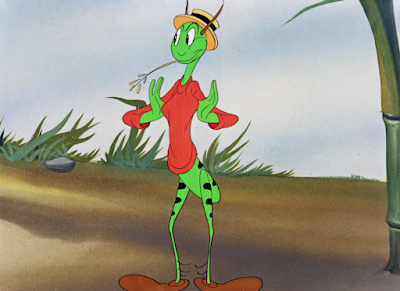
















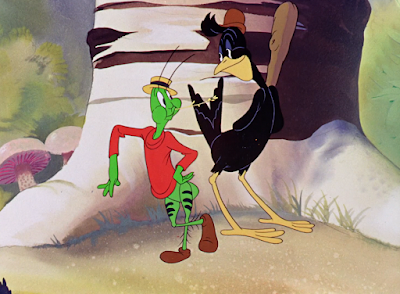















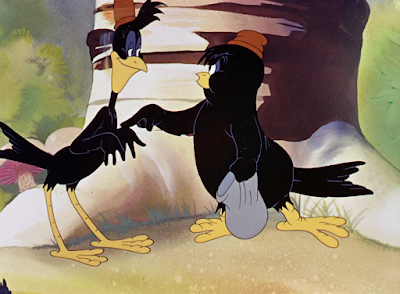




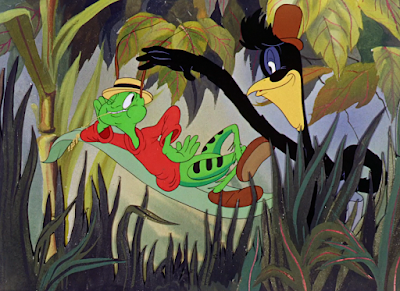






































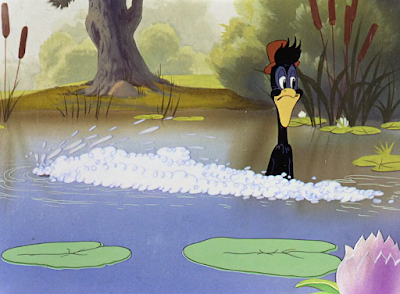







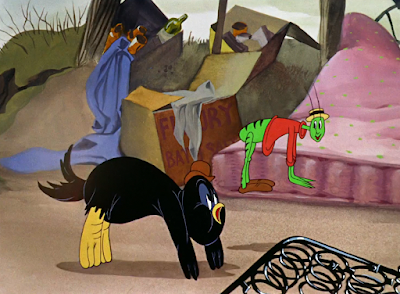



















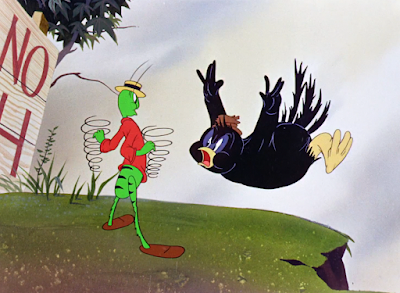






























































No comments:
Post a Comment